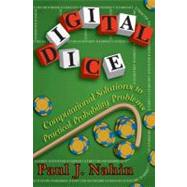
Note: Supplemental materials are not guaranteed with Rental or Used book purchases.
Purchase Benefits
What is included with this book?
| Introduction | p. 1 |
| The Problems | p. 35 |
| The Clumsy Dishwasher Problem | p. 37 |
| Will Lil and Bill Meet at the Malt Shop? | p. 38 |
| A Parallel Parking Question | p. 40 |
| A Curious Coin-Flipping Game | p. 42 |
| The Gamow-Stern Elevator Puzzle | p. 45 |
| Steve's Elevator Problem | p. 48 |
| The Pipe Smoker's Discovery | p. 51 |
| A Toilet Paper Dilemma | p. 53 |
| The Forgetful Burglar Problem | p. 59 |
| The Umbrella Quandary | p. 61 |
| The Case of the Missing Senators | p. 63 |
| How Many Runners in a Marathon? | p. 65 |
| A Police Patrol Problem | p. 69 |
| Parrondo's Paradox | p. 74 |
| How Long Is the Wait to Get the Potato Salad? | p. 77 |
| The Appeals Court Paradox | p. 81 |
| Waiting for Buses | p. 83 |
| Waiting for Stoplights | p. 85 |
| Electing Emperors and Popes | p. 87 |
| An Optimal Stopping Problem | p. 91 |
| Chain Reactions, Branching Processes, and Baby Boys | p. 96 |
| MATLAB Solutions To The Problems | p. 101 |
| The Clumsy Dishwasher Problem | p. 103 |
| Will Lil and Bill Meet at the Malt Shop? | p. 105 |
| A Parallel Parking Question | p. 109 |
| A Curious Coin-Flipping Game | p. 114 |
| The Gamow-Stern Elevator Puzzle | p. 120 |
| Steve's Elevator Problem | p. 124 |
| The Pipe Smoker's Discovery | p. 129 |
| A Toilet Paper Dilemma | p. 140 |
| The Forgetful Burglar Problem | p. 144 |
| The Umbrella Quandary | p. 148 |
| The Case of the Missing Senators | p. 153 |
| How Many Runners in a Marathon? | p. 157 |
| A Police Patrol Problem | p. 160 |
| Parrondo's Paradox | p. 169 |
| How Long is the Wait to Get the Potato Salad? | p. 176 |
| The Appeals Court Paradox | p. 184 |
| Waiting for Buses | p. 187 |
| Waiting for Stoplights | p. 191 |
| Electing Emperors and Popes | p. 197 |
| An Optimal Stopping Problem | p. 204 |
| Chain Reactions, Branching Processes, and Baby Boys | p. 213 |
| One Way to Guess on a Test | p. 221 |
| An Example of Variance-Reduction in the Monte Carlo Method | p. 223 |
| Random Harmonic Sums | p. 229 |
| Solving Montmort's Problem by Recursion | p. 231 |
| An Illustration of the Inclusion-Exclusion Principle | p. 237 |
| Solutions to the Spin Game | p. 244 |
| How to Simulate Kelvin's Fair Coin with a Biased Coin | p. 248 |
| How to Simulate an Exponential Random Variable | p. 252 |
| Index to Author-Created MATLAB m-Files in the Book | p. 255 |
| Glossary | p. 257 |
| Acknowledgments | p. 259 |
| Index | p. 261 |
| Table of Contents provided by Ingram. All Rights Reserved. |
The New copy of this book will include any supplemental materials advertised. Please check the title of the book to determine if it should include any access cards, study guides, lab manuals, CDs, etc.
The Used, Rental and eBook copies of this book are not guaranteed to include any supplemental materials. Typically, only the book itself is included. This is true even if the title states it includes any access cards, study guides, lab manuals, CDs, etc.